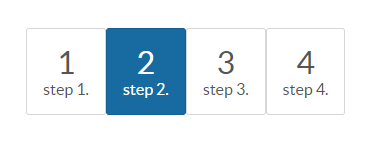Wow, that's a nice question!
I've tried many things with the current API to accomplish it, but seems like it's not possible with our current options.
To solve this I wrote a custom renderer for the Steps component:
Most of the code below is the same from the PrimeFaces's GitHub. I just changed a few things to solve this specific problem.
import java.io.IOException;
import java.util.ArrayList;
import java.util.LinkedHashMap;
import java.util.List;
import java.util.Map;
import javax.faces.FacesException;
import javax.faces.component.UIComponent;
import javax.faces.context.FacesContext;
import javax.faces.context.ResponseWriter;
import org.primefaces.component.api.AjaxSource;
import org.primefaces.component.api.UIOutcomeTarget;
import org.primefaces.component.steps.Steps;
import org.primefaces.component.steps.StepsRenderer;
import org.primefaces.model.menu.MenuItem;
import org.primefaces.util.ComponentTraversalUtils;
public class CustomStepsRenderer extends StepsRenderer {
@Override
protected void encodeItem(FacesContext context, Steps steps, MenuItem item, int activeIndex, int index) throws IOException {
ResponseWriter writer = context.getResponseWriter();
String itemClass;
if (steps.isReadonly()) {
itemClass = (index == activeIndex) ? Steps.ACTIVE_ITEM_CLASS : Steps.INACTIVE_ITEM_CLASS;
} else {
if (index == activeIndex) {
itemClass = Steps.ACTIVE_ITEM_CLASS;
}
else {
itemClass = Steps.VISITED_ITEM_CLASS;
}
}
String containerStyle = item.getContainerStyle();
String containerStyleClass = item.getContainerStyleClass();
if (containerStyleClass != null) {
itemClass = itemClass + " " + containerStyleClass;
}
//header container
writer.startElement("li", null);
writer.writeAttribute("class", itemClass, null);
writer.writeAttribute("role", "tab", null);
if (containerStyle != null) {
writer.writeAttribute("style", containerStyle, null);
}
encodeMenuItem(context, steps, item, activeIndex, index);
writer.endElement("li");
}
@Override
protected void encodeMenuItem(FacesContext context, Steps steps, MenuItem menuitem, int activeIndex, int index) throws IOException {
ResponseWriter writer = context.getResponseWriter();
String title = menuitem.getTitle();
String style = menuitem.getStyle();
String styleClass = this.getLinkStyleClass(menuitem);
writer.startElement("a", null);
writer.writeAttribute("tabindex", "-1", null);
if (shouldRenderId(menuitem)) {
writer.writeAttribute("id", menuitem.getClientId(), null);
}
if (title != null) {
writer.writeAttribute("title", title, null);
}
writer.writeAttribute("class", styleClass, null);
if (style != null) {
writer.writeAttribute("style", style, null);
}
if (steps.isReadonly() || menuitem.isDisabled()) {
writer.writeAttribute("href", "#", null);
writer.writeAttribute("onclick", "return false;", null);
} else {
String onclick = menuitem.getOnclick();
//GET
if (menuitem.getUrl() != null || menuitem.getOutcome() != null) {
String targetURL = getTargetURL(context, (UIOutcomeTarget) menuitem);
writer.writeAttribute("href", targetURL, null);
if (menuitem.getTarget() != null) {
writer.writeAttribute("target", menuitem.getTarget(), null);
}
} //POST
else {
writer.writeAttribute("href", "#", null);
UIComponent form = ComponentTraversalUtils.closestForm(context, steps);
if (form == null) {
throw new FacesException("MenuItem must be inside a form element");
}
String command;
if (menuitem.isDynamic()) {
String menuClientId = steps.getClientId(context);
Map<String, List<String>> params = menuitem.getParams();
if (params == null) {
params = new LinkedHashMap<String, List<String>>();
}
List<String> idParams = new ArrayList<String>();
idParams.add(menuitem.getId());
params.put(menuClientId + "_menuid", idParams);
command = menuitem.isAjax()
? buildAjaxRequest(context, steps, (AjaxSource) menuitem, form, params)
: buildNonAjaxRequest(context, steps, form, menuClientId, params, true);
} else {
command = menuitem.isAjax()
? buildAjaxRequest(context, (AjaxSource) menuitem, form)
: buildNonAjaxRequest(context, ((UIComponent) menuitem), form, ((UIComponent) menuitem).getClientId(context), true);
}
onclick = (onclick == null) ? command : onclick + ";" + command;
}
if (onclick != null) {
writer.writeAttribute("onclick", onclick, null);
}
}
writer.startElement("span", steps);
writer.writeAttribute("class", Steps.STEP_NUMBER_CLASS, null);
writer.writeText((index + 1), null);
writer.endElement("span");
Object value = menuitem.getValue();
if (value != null) {
writer.startElement("span", steps);
writer.writeAttribute("class", Steps.STEP_TITLE_CLASS, null);
writer.writeText(value, null);
writer.endElement("span");
}
writer.endElement("a");
}
Then, register this new renderer in your faces-config.xml file:
<render-kit>
<renderer>
<component-family>org.primefaces.component</component-family>
<renderer-type>org.primefaces.component.StepsRenderer</renderer-type>
<renderer-class>YOUR_PACKAGE.CustomStepsRenderer</renderer-class>
</renderer>
</render-kit>
Don't forget to change YOUR_PACKAGE to your CustomStepsRenderer package location.
After that, just build/re-deploy your application and everything should work fine:
![enter image description here]()



p:steps? – Hysterogenic